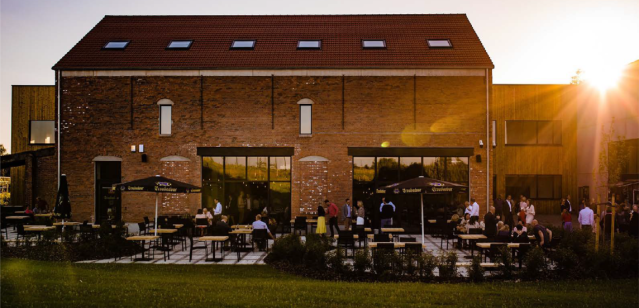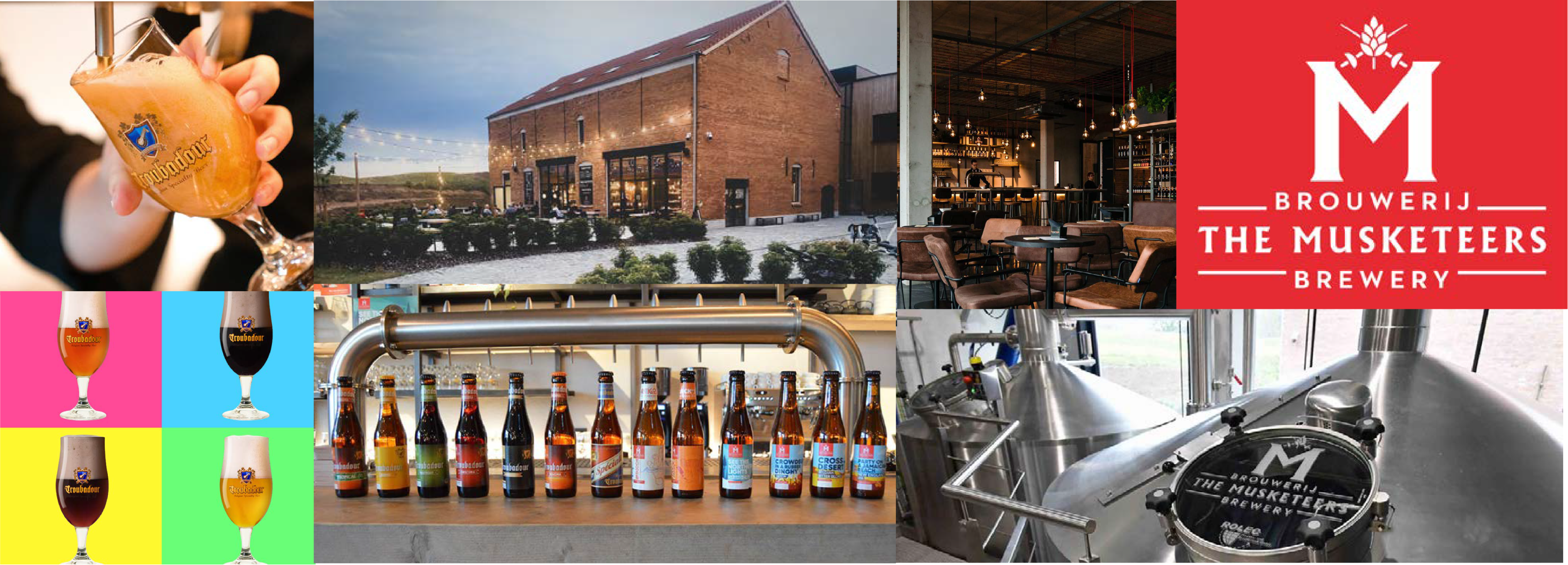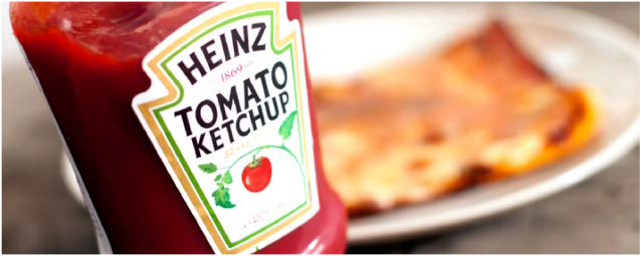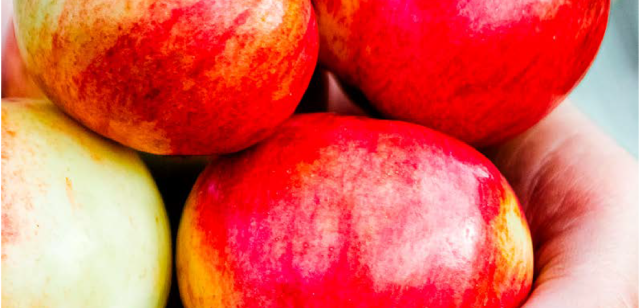
Production and bottling of the musketeers beer
Case Study

production and bottling of the musketeers beer
Case Study
Two years ago when I first received notice of a project for a new beer production and bottling plant in the north of Belgium, the idea piqued my interest straight away. We like to work on the fruition of new projects, even more so when they are in a place that is traditionally linked to the product in question. It was just the case with Belgian beer, that has been added to the 2016 UNESCO Intangible Cultural Heritage of Humanity list. Worthy recognition of a product known and loved the world over.
Our company Rolec, which has been part of the CFT Group since 2017 and represents excellence in beer production machinery, met with the founders of The Musketeers brewery because they were looking for a partner who could help them build their new brewery. What the “musketeers” needed was to start producing and bottling their own beers, including the famous Troubadour.Our company Rolec, which has been part of the CFT Group since 2017 and represents excellence in beer production machinery, met with the founders of The Musketeers brewery because they were looking for a partner who could help them build their new brewery. What the “musketeers” needed was to start producing and bottling their own beers, including the famous Troubadour.
Two years ago when I first received notice of a project for a new beer production and bottling plant in the north of Belgium, the idea piqued my interest straight away. We like to work on the fruition of new projects, even more so when they are in a place that is traditionally linked to the product in question. It was just the case with Belgian beer, that has been added to the 2016 UNESCO Intangible Cultural Heritage of Humanity list. Worthy recognition of a product known and loved the world over.
Our company Rolec, which has been part of the CFT Group since 2017 and represents excellence in beer production machinery, met with the founders of The Musketeers brewery because they were looking for a partner who could help them build their new brewery. What the “musketeers” needed was to start producing and bottling their own beers, including the famous Troubadour.
Two years ago when I first received notice of a project for a new beer production and bottling plant in the north of Belgium, the idea piqued my interest straight away. We like to work on the fruition of new projects, even more so when they are in a place that is traditionally linked to the product in question. It was just the case with Belgian beer, that has been added to the 2016 UNESCO Intangible Cultural Heritage of Humanity list. Worthy recognition of a product known and loved the world over.
Our company Rolec, which has been part of the CFT Group since 2017 and represents excellence in beer production machinery, met with the founders of The Musketeers brewery because they were looking for a partner who could help them build their new brewery. What the “musketeers” needed was to start producing and bottling their own beers, including the famous Troubadour.
The musketeers brewery
The “musketeers’” brewery came about thanks to the passion of four Belgian engineers, who had made their debut in 1999 by putting their first beer on the market. Almost twenty years later, two of them decided to open their own premises for producing and bottling beer.
The project for the new brewery immediately seemed to me to be completely in line with the spirit of the CFT Group, because it is based on the concepts of passion, innovation and sustainability, with an eye to the origins of the place where it was built.
The new building, 30 minutes by car from Antwerp, stands in an old abandoned artisan area that used to produce bricks. The building has been renovated with great respect for its origins and several of the ancient elements have been preserved. To the side of the brewery, for example, you can still see the slope where the clay wagons were pulled up. For the rest, the old furnace has been transformed into an attractive beer bar with a spacious terrace.
The musketeers have also paid particular attention to sustainability: the basic idea, which CFT Group fully agrees with, is that it is really important to keep the carbon footprint as small as possible. Hence the need to have a system where energy and water are carefully managed and not wasted. The recovery of the heat generated during production and the use of rainwater to wash part of the equipment are two examples in this sense.
Raw materials are also chosen with care, favouring local producers of hops and malt. The waste from the malt is collected and used by a local farmer. The CO2 needed for beer production is obtained from a natural process, which is the fermentation of leftover maize.
The musketeers brewery
The “musketeers’” brewery came about thanks to the passion of four Belgian engineers, who had made their debut in 1999 by putting their first beer on the market. Almost twenty years later, two of them decided to open their own premises for producing and bottling beer.
The project for the new brewery immediately seemed to me to be completely in line with the spirit of the CFT Group, because it is based on the concepts of passion, innovation and sustainability, with an eye to the origins of the place where it was built.
The new building, 30 minutes by car from Antwerp, stands in an old abandoned artisan area that used to produce bricks. The building has been renovated with great respect for its origins and several of the ancient elements have been preserved. To the side of the brewery, for example, you can still see the slope where the clay wagons were pulled up. For the rest, the old furnace has been transformed into an attractive beer bar with a spacious terrace.
The musketeers have also paid particular attention to sustainability: the basic idea, which CFT Group fully agrees with, is that it is really important to keep the carbon footprint as small as possible. Hence the need to have a system where energy and water are carefully managed and not wasted. The recovery of the heat generated during production and the use of rainwater to wash part of the equipment are two examples in this sense.
Raw materials are also chosen with care, favouring local producers of hops and malt. The waste from the malt is collected and used by a local farmer. The CO2 needed for beer production is obtained from a natural process, which is the fermentation of leftover maize.
The musketeers brewery
The “musketeers’” brewery came about thanks to the passion of four Belgian engineers, who had made their debut in 1999 by putting their first beer on the market. Almost twenty years later, two of them decided to open their own premises for producing and bottling beer.
The project for the new brewery immediately seemed to me to be completely in line with the spirit of the CFT Group, because it is based on the concepts of passion, innovation and sustainability, with an eye to the origins of the place where it was built.
The new building, 30 minutes by car from Antwerp, stands in an old abandoned artisan area that used to produce bricks. The building has been renovated with great respect for its origins and several of the ancient elements have been preserved. To the side of the brewery, for example, you can still see the slope where the clay wagons were pulled up. For the rest, the old furnace has been transformed into an attractive beer bar with a spacious terrace.
The musketeers have also paid particular attention to sustainability: the basic idea, which CFT Group fully agrees with, is that it is really important to keep the carbon footprint as small as possible. Hence the need to have a system where energy and water are carefully managed and not wasted. The recovery of the heat generated during production and the use of rainwater to wash part of the equipment are two examples in this sense.
Raw materials are also chosen with care, favouring local producers of hops and malt. The waste from the malt is collected and used by a local farmer. The CO2 needed for beer production is obtained from a natural process, which is the fermentation of leftover maize.

THE CFT GROUP PROJECT
The founders of the brewery, Stefaan Soetemans and Kristof De Roo, wanted to place a beer production and bottling space alongside the new pub where they could install the machines necessary to complete the entire work process, from the bringing in of the raw material through to the bottling and packaging.
Given the small spaces we had available, we passionately set to work on designing a customized layout that could satisfy all the productivity and product quality needs that the client had asked of us.
After a very intense challenge with several competitors, we managed to convince Stefaan and Kristof of the worthiness of our proposal and the advantage of having a single representative for all aspects of the project.
In summary, these are the main machines supplied by CFT Group for this project:
The cft Group Project
The founders of the brewery, Stefaan Soetemans and Kristof De Roo, wanted to place a beer production and bottling space alongside the new pub where they could install the machines necessary to complete the entire work process, from the bringing in of the raw material through to the bottling and packaging.
Given the small spaces we had available, we passionately set to work on designing a customized layout that could satisfy all the productivity and product quality needs that the client had asked of us.
After a very intense challenge with several competitors, we managed to convince Stefaan and Kristof of the worthiness of our proposal and the advantage of having a single representative for all aspects of the project.
In summary, these are the main machines supplied by CFT Group for this project:
the cft group project
The founders of the brewery, Stefaan Soetemans and Kristof De Roo, wanted to place a beer production and bottling space alongside the new pub where they could install the machines necessary to complete the entire work process, from the bringing in of the raw material through to the bottling and packaging.
Given the small spaces we had available, we passionately set to work on designing a customized layout that could satisfy all the productivity and product quality needs that the client had asked of us.
After a very intense challenge with several competitors, we managed to convince Stefaan and Kristof of the worthiness of our proposal and the advantage of having a single representative for all aspects of the project.
In summary, these are the main machines supplied by CFT Group for this project:
Rolec Brewery
A fully automated 40-hectolitre brewery was installed for this project, which manages the treatment and milling of the malt, the boiling and cooling of the wort.
CFT 151 Depal from below
Master RS Glass
The supply is then completed by a labelling machine and can be further expanded in the future, by implementing a robotic solution for the secondary packaging of the filled bottles.
The Musketeers brewery is today able to produce 8,000 hectolitres of beer a year, which is equivalent to 3 million bottles. The project presented us with a real challenge and we are really pleased with the final result. In particular, we are really satisfied with how we managed to blend in with a modern environment that is at the same time tied to tradition, where the search for a product that is always new and different goes hand in hand with attention to environmental impact. They are the same principles that guide our group and we are happy when we can help our customers follow them.
MARKET PROSPECTS
“The global beer market is project to grow at a CAGR of 5.5% by 2025.”
Lifestyle changes, rising alcohol consumption rate, rapid urbanization, high disposable income and the popularity of beer among the young population are some of the factors driving this industry.
The introduction of new innovative ingredients and flavours and the combination of salty, fruity and tart flavours of craft beers has found a growing global appeal, particularly among young people.
MARKET PROSPECTS
“The global beer market is project to grow at a CAGR of 5.5% by 2025.”
Lifestyle changes, rising alcohol consumption rate, rapid urbanization, high disposable income and the popularity of beer among the young population are some of the factors driving this industry.
The introduction of new innovative ingredients and flavours and the combination of salty, fruity and tart flavours of craft beers has found a growing global appeal, particularly among young people.
Case Study
Case Study
Heinz and CFT: together for ketchup processing CFT and Heinz have worked together since the beginning of CFT’s history, in the 1950s. Our founder Camillo Catelli collaborated assiduously with the Heinz managers of that time, to innovate and expand the American tomato processing industry, in particular for the production of Tomato Ketchup. This cooperation provided
Case Study
Two years ago when I first received notice of a project for a new beer production and bottling plant in the north of Belgium, the idea piqued my interest straight away. We like to work on the fruition of new projects, even more so when they are in a place that is traditionally linked to
Case Study
ORGANIC FRUIT PURÉE PRODUCTION Fénix S. A. was founded in 1995 and is entirely dedicated to the production of fruit and vegetable purée. The company is located in General Alvear, Mendoza, Argentina. The founder, Mario Perón, in addition to his constant search for quality, also shared his Italian origins with CFT. He had actually arrived



